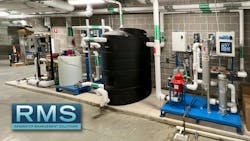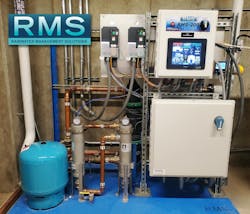Collaborative Effort Helps Rainwater Harvesting Reach Pivotal Benchmark
In what is considered a breakthrough for rainwater codes and standards moving forward, the United States General Services Administration (GSA) has accepted its proposed change for the Facilities Standards for the Public Buildings Service (P100), requiring major capital projects of more than 5,000 sq. ft. employing rooftop rainwater catchment and harvesting systems to comply with relevant ARCSA/ASPE/ANSI standards.
“This definitely sets a precedent,” says Heather Kinkade, Executive Director, American Rainwater Catchment Systems Association (ARCSA) International. “Finally, people are starting to recognize that water is important. And while we've been working at this for 30 years, people are just now starting to say, ‘we've got to do something about this.’”
Dain Hansen, Executive Vice President, Government Relations, The IAPMO Group, concurs, “This sets a fantastic precedent since the GSA is the big player in the room when it comes to federal facilities, when it comes to federal requirements. It not only sets a precedent for other federal agencies, but it could also create a domino effect for states and jurisdictions,” says Hansen.
In the proposed change, rainwater catchment and harvesting systems from architectural rooftops must comply with ARCSA/ASPE/ANSI Standard 63-2020: Rainwater Catchment Systems, while systems harvesting sidewalk, plaza, and/ or parking lot runoff must comply with ARCSA/ASPE/ANSI 78: Stormwater Harvesting System Design for Direct End-Use Applications. In addition to the above, capital projects may use recycled water sourced from a centralized treatment facility to meet these requirements. Testing of the recycled water must be conducted to determine if the chemistry is compatible for sustaining the proposed plant palette.
Teamwork Makes the Dream Work
What was the engine behind this rainwater standardization movement? Behind the scenes, collaboration and persistence came into focus. ARCSA’s Kinkade set up initial meetings with the GSA regarding its designs on standardizing rainwater packages on a national/international basis. The collaborative team eventually received a call from GSA but, according to David Crawford, CEO, Rainwater Management Solutions (RMS), ARCSA couldn't quite handle the entire scope. “So, RMS bid on it and won the bid, and we researched 17 of their systems. During the research of those systems, we brought up factors of inconsistent design, systems that weren't working, and maintenance protocol, and in the middle of all that, ARCSA re-emerged to help get it over the finish line,” says Crawford.
With the ardent support and help from IAPMO, ARCSA submitted the proposed change for P100—which establishes mandatory design standards and performance criteria for GSA-owned buildings—last fall (2023). “The P100 is GSAs construction manual best practices—code, standards, accreditation—everything required to do work within a federal facility, a federal building, or federal entity,” says Hansen. These newly-defined standards are now not just encouraged but mandated in the GSA P100, “which includes all federal facilities that are under GSAs purview. This is a big, big step,” says Hansen.
Because these standards are in the infancy stages in terms of the language, “One thing we'll have to do is to track this to see how this engages, because if there's confusion on the ground or if there's confusion with the practitioners, then we're going have to seek additional clarification, stipulations or definitions within GSA in the future. Getting in was the really heavy lifting, and we can refine moving forward as needed,” says Hansen.
In terms of “codes and standard years,” the adoption moved relatively quickly. “This shows the power of a collaborative team effort between ARCSA and IAPMO,” says Hansen. “They laid the groundwork, as Rainwater Management Systems (RMS) has done a lot of great work in DC for us. We met with everyone from the top leadership at GSA down to the staff that manage the P100, and as a result, this is the first time that the GSA has actually mandated a water reuse component. They're now seeing this appetite, for it and I believe that the GSA is going to see a lot of benefits from this really quickly,” continues Hansen. ARCSA plans to continue spreading the word about its rainwater and stormwater standards and knows they would not be where they are without the initial help from the American Society of Plumbing Engineers (ASPE).
5 Steps of Rainwater Treatment Consistency
According to ARCSA’s Kinkade, “Our systems are totally different than just a typical rainwater system, and we are not keeping it secret. We want everyone using the same steps to provide the cleanest possible water. By requiring Standards 63 and 78, everybody is creating the same basic systems. Now you can have the maintenance team go from one system to another and they know exactly what is required. In essence, GSA gets that consistency that all of their systems are the same.”
David Crawford, RMS, says that in accordance with Standards 63 and 78, there are five steps to keep rainwater treatment consistent.
Step 1 — Pre-treat or filter the water as it comes off the roof.
Step 2 — Do not disturbed the water in the tank. We use what's called a calming unit that reflects the incoming water upward to eliminate disturbing sediment that may be in the tank.
Step 3 — Use the cleanest water in the tank by using a floating intake that's four inches below the surface, but would shut off if it reached the bottom of the tank. (Any suspended solids typically settle to the bottom or float to the top and a floating intake will not disturb either.)
Step 4 — Use an overflow device which skims pollen and other floating debris out of the tank but also prevents critters and other things to back up into the tank.
Step 5 — Point of treatment based on use. “If it’s going out for irrigation, we might not have to do as much as we would treatment wise than if we were bringing it back in the building to flush toilets. Our company has always brought it to a potable level, and that's pretty consistent with standard 63,” says Crawford. “If people are going to come in contact with it, the water should be at a potable level.
“If it is providing a potable supply, then we're adding a few other things which are safeguards such as a UV treatment. If for some reason a purification system was not performing to its design, the UV light and that system would sense an error and it would automatically shut that system off,” says Crawford.




